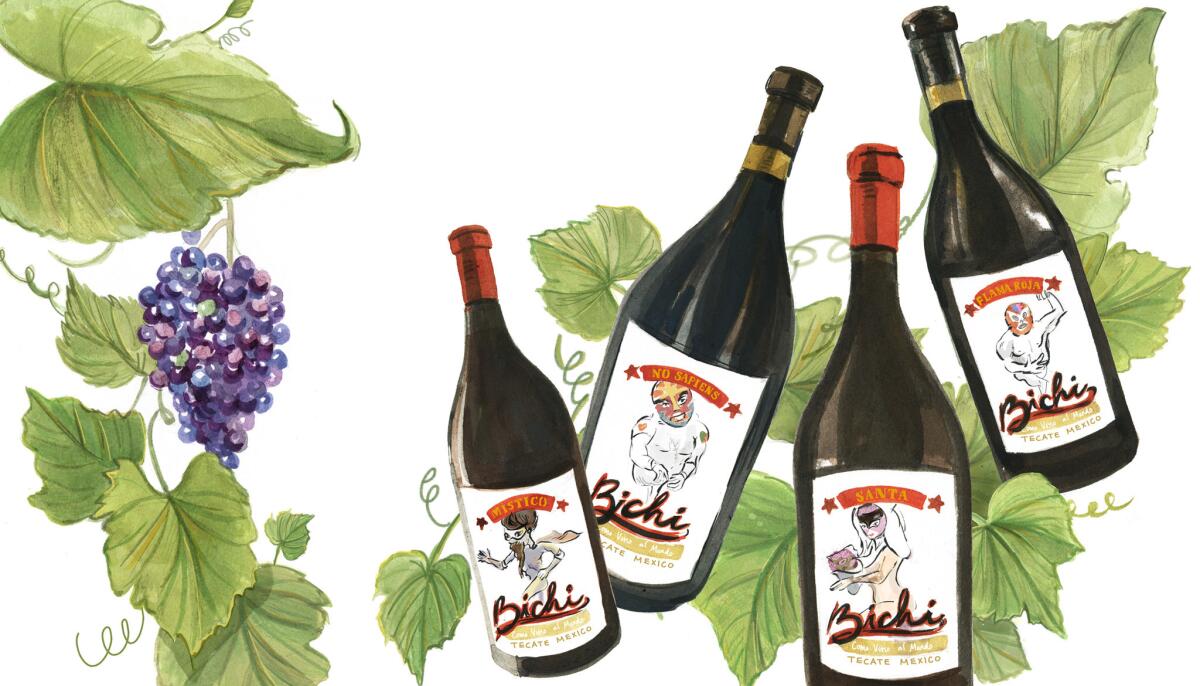The Mission grape is cool in L.A. again, thanks to the natural wine movement

- Share via
Noel Tellez is tired.
“All gone,” the Mexican winemaker says, gesturing at a table of empty bottles at a natural-wine fair at City Market Social House, a glossy warehouse space just south of skid row on San Pedro Street. Tellez, who traveled to Los Angeles from his native Mexico, has been pouring a smoky, young red wine made from an obscure varietal called misión, the Mission grape.
He squints, as if it was suddenly bright.
“Why do people like it so much?”
The Mission grape makes a wine that is far from your typical house red. It can smell like mezcal, and taste like hibiscus and iron. But most importantly, in the hands of natural winemakers like Tellez, the Mission grape, which has a long history in L.A., has taken on an elusive quality: It’s cool.
Read more about the Mission grape and the history of wine in L.A. »
In L.A., Tellez is a natural-wine darling, and the Mission grape is his flavor of the month. While in town, he was feted with a tasting and Q&A at Now Serving, the Chinatown cookbook store. Bichi, the name of his winemaking operation, is a hot ticket at wine shops Lou in Los Feliz, Domaine LA in Hollywood and Silverlake Wine, and at natural-wine-centric restaurants such as Night+Market.
Natural winemakers, retailers and consumers love wines made from grapes with names you don’t see on the bottles at Trader Joe’s, like the Mission grape. It adds to the general mystique that is part of natural wine’s appeal. Though not a regulated term, it generally refers to low-production wines made with minimal intervention. Natural winemakers eschew pesticides and additives and all manner of things common to more mainstream wines. (What is in or out is determined on a winery-by-winery basis; there are no actual rules.) By — again, generally — interfering as little as possible, they say things like that they are allowing the wine to be what it wants to be.
“Back in the day nobody wanted these wines,” says Sarah Yenbamroong who, with her husband, Kris, runs the Night+Market family of restaurants; the two were early adopters of natural wine. “Now every restaurant in the city is expected to have natural wine on its list.”
The story of how Jonathan Gold “saved” Night+Market »
Now the rapper Action Bronson trumpets natural wine on his television show; the comedian Eric Wareheim makes natural wine; and whereas 11 years ago there were none, there are now more than a half-dozen natural-wine-focused shops in Los Angeles, plus dedicated bars and restaurants with exclusively natural wine on their lists.
Jill Bernheimer, owner of Domaine LA, has seen the city’s interest in natural wine grow dramatically in her 10 years in business at her Melrose Avenue store, which regularly stocks — and then quickly sells out of — Tellez’s wines.
“People love Bichi,” Bernheimer says, attributing the appeal of grapes like the Mission to “the gestalt of each bottle.” The Mission grape, she says, “tastes like blood.”
“They love the idiosyncrasy of where Bichi is located,” in Tecate, Mexico. “They love the labels,” which feature drawings of scantily clad lucha libre fighters. “And there’s a cool factor at work that undermines the traditional narratives about California wine and Napa.”
Wine drinkers love a story, and the Mission grape has a good one that goes back hundreds of years in L.A., where Mission grape vines once lined the banks of the river.
The Mission grape first came to the city from Spain, where it is known as listán prieto, with Father Junípero Serra, whose priests planted vines from New Mexico down to Baja; it is also grown in Peru and Chile, where it is known as criolla and pais. By 1850, the year California became a state, L.A. County was home to 100 vineyards and wineries.
During Prohibition, the Tecate vineyards that Tellez farms today produced wine that was smuggled into America. As California became famous for wine, and Tecate became a beer town, the Mission grape all but disappeared from the region. The Mission’s ancestral relation, listán prieto, also nearly died out in Spain, and now is mostly grown in the Canary Islands.
According to the Department of Agriculture, there are about 400 acres of Mission grapes statewide, compared with the 10,000 acres estimated in Santa Ana alone in the 1850s.
Many vines are left uncultivated, or their grapes are blended for jug wine. Rarely, they are made into Angelica — a sweet fortified wine the mission priests made — notably by Santa Barbara’s Gypsy Canyon and San Francisco’s Harrington Wines, which also bottles a dry version. A Los Angeles city archivist named Michael Holland tends to two hybrid Mission grape plants growing behind the Avila Adobe, L.A.’s oldest structure, on Olvera Street, and makes wine from them.
In the land of Cabernet, the Mission grape has its critics. A winemaker I spoke to called it “flabby, spineless.” It doesn’t age well; it isn’t a wine for the cellar. But even detractors see its value.
Despite saying Mission grape wine tastes like “a wet hamster going down,” local wine historian Ned Teitelbaum plans to plant Mission grapes in public spaces around the city. He hopes that the grape, which has survived across cultures and time periods and borders, can have a more permanent place in L.A., where once it was so prominent but now exists only as an import.
“The story behind the wine,” he says, “has become more important than the wine.”
»
More to Read
Eat your way across L.A.
Get our weekly Tasting Notes newsletter for reviews, news and more.
You may occasionally receive promotional content from the Los Angeles Times.










